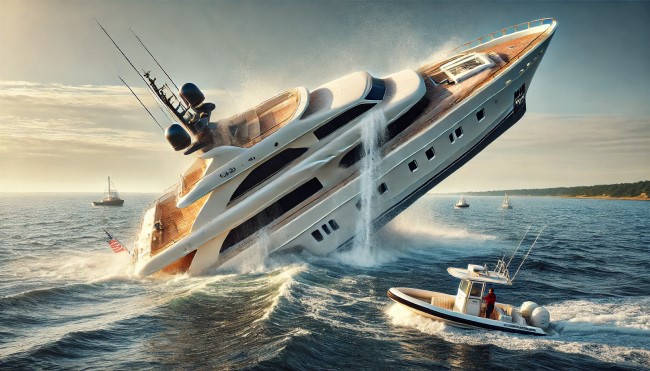$8 Million Yacht Capsizes Near Annapolis: An In-Depth Analysis of the Incident and Its Implications

The serene waters near Annapolis, Maryland, recently witnessed a dramatic and unfortunate event that has captured the attention of maritime enthusiasts and the general public alike. The Lovebug, a luxurious $8 million yacht, capsized near the mouth of the Rhode River, just eight nautical miles south of Annapolis. The incident has raised numerous questions regarding maritime safety, vessel maintenance, and the potential environmental impact of such accidents. In this article, we will delve into the details of the Lovebug‘s capsize, explore the factors that may have contributed to the incident, and discuss the broader implications for the maritime industry.
The Incident: What Happened?
On a seemingly ordinary Saturday, the U.S. Coast Guard received a distress call from the Lovebug, a 122-foot Italian-built yacht, around 12:30 p.m. The vessel was reported to be taking on water and listing dangerously to one side. Despite the captain’s efforts to navigate the yacht to shallower waters, the situation rapidly deteriorated, forcing the crew and passengers to abandon ship.
The yacht, which had been available for charter at a staggering $125,000 per week, was known for its opulence, including a jet ski garage and zero-speed stabilizers. However, none of these luxurious features could prevent the vessel from succumbing to the forces of nature. Within minutes, the yacht was nearly submerged, resting precariously on its starboard side, with only a portion visible above water.
Rescue Efforts: A Community Unites
The quick response from nearby boaters, along with the U.S. Coast Guard and Maryland Natural Resources Police, played a crucial role in ensuring the safety of everyone on board. Trevor Hardman, the owner of Tour Boat Annapolis, was one of the first to respond to the distress call. His account of the rescue highlights the teamwork and composure that were vital in preventing a tragedy.
“We heard the captain call for help as the boat was taking on water,” Hardman recalled. “We went to the boat and got the captain, the last one onboard. He stated he did not run aground, but the boat started taking on water. He headed to shallow water before they abandoned ship.”
The passengers and crew were safely rescued, with no serious injuries reported. The only minor incident was a complaint of head soreness from one individual, who declined to be taken to the hospital. The rapid and efficient rescue operation is a testament to the strong sense of community among boaters and the effectiveness of emergency response protocols.
Environmental Concerns: Addressing the Aftermath
While the immediate priority was the safety of the people on board, attention quickly turned to the environmental impact of the incident. The U.S. Coast Guard, in collaboration with a local salvage company, deployed oil boom barriers around the yacht to contain any potential fuel spills. Given the size and nature of the vessel, the risk of environmental contamination was significant.
Fortunately, it appears that all of the fuel was contained within the barriers, preventing a more severe environmental disaster. However, the incident serves as a stark reminder of the vulnerabilities associated with large, fuel-intensive vessels in sensitive aquatic environments. The next steps involve salvaging the yacht and conducting a thorough investigation to determine the cause of the capsize.
Investigating the Cause: What Went Wrong?
One of the most pressing questions following the incident is what caused the Lovebug to capsize. According to initial reports, the captain did not believe the yacht had run aground, but rather that it began taking on water for reasons yet to be determined. Modern yachts like the Lovebug are equipped with high-water alarms and other safety features designed to prevent such occurrences. However, these systems were not enough to avert disaster.
Several potential factors could have contributed to the incident:
- Structural Integrity: Over time, even the most well-maintained vessels can develop structural issues that may not be immediately apparent. A small crack or weak spot in the hull could have allowed water to enter the yacht, leading to the rapid listing observed.
- Mechanical Failure: The Lovebug was equipped with advanced stabilization systems designed to provide a smooth ride even in rough seas. If these systems malfunctioned, they could have contributed to the vessel’s instability.
- Human Error: While the captain’s quick decision-making likely prevented a more severe outcome, human error cannot be ruled out as a contributing factor. A misjudgment in navigating the vessel or an oversight in routine maintenance could have played a role.
- Weather Conditions: Although there were no reports of severe weather at the time of the incident, even moderate waves or wind can exacerbate existing issues on a compromised vessel. The investigation will need to consider the environmental conditions leading up to the capsize.
The Role of Maritime Safety Regulations
The Lovebug incident underscores the importance of stringent maritime safety regulations and the need for constant vigilance in enforcing them. The U.S. Coast Guard, along with other regulatory bodies, plays a crucial role in ensuring that vessels operating in U.S. waters meet the highest safety standards. However, as this incident demonstrates, even luxury yachts with the latest technology are not immune to accidents.
This event may prompt a review of current regulations, particularly concerning the maintenance and inspection of large yachts. Owners and operators may face increased scrutiny to ensure that their vessels are seaworthy and compliant with all safety protocols. Additionally, this incident highlights the importance of proper training for crew members, who must be prepared to respond to emergencies swiftly and effectively.
Implications for the Yacht Industry
The capsize of a high-profile yacht like the Lovebug could have broader implications for the luxury yacht industry. Potential clients may become more cautious about chartering expensive vessels, particularly if concerns about safety are not adequately addressed. Yacht manufacturers and charter companies may need to take additional steps to reassure customers that their vessels are safe and reliable.
Moreover, the incident could lead to increased insurance premiums for yacht owners and operators, as insurers reassess the risks associated with high-value vessels. The financial impact of the incident on the yacht’s owner and the charter company could be significant, particularly if the investigation reveals negligence or failure to adhere to safety standards.
Lessons Learned: Moving Forward After the Incident
As the investigation into the Lovebug‘s capsize continues, the maritime community must take the opportunity to learn from this incident. Whether the cause was mechanical, structural, or human error, it is essential that the lessons learned are applied to prevent future occurrences. This may involve revisiting maintenance schedules, enhancing crew training, or updating safety regulations to reflect the latest technological advancements in yacht design.
The incident also serves as a reminder of the importance of community and cooperation on the water. The swift response from nearby boaters and emergency services undoubtedly saved lives and minimized the environmental impact. This sense of solidarity and mutual support is a cornerstone of maritime culture and will be crucial in addressing any future challenges that arise.
Conclusion
The Lovebug‘s capsize near Annapolis is a sobering reminder of the inherent risks of maritime travel, even for the most luxurious and well-equipped vessels. As the investigation unfolds, it is crucial that the maritime industry takes this opportunity to reflect on current practices and make any necessary changes to enhance safety and protect the environment. For now, the priority remains salvaging the vessel and uncovering the truth behind this dramatic incident, while the broader implications for the yacht industry continue to emerge.



